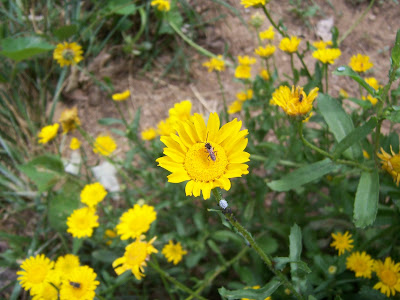Every plant-loving gardener massacres plants by the tens of thousands every year. A market gardener kills millions every week. And their only crime is that they are seeking their place in the sun. Tragic isn't it? For them, natural selection has been superseded by the whim of a bloke with a sharp stick.
Chas Griffin from More Scenes from a Smallholding
It's the time of year again where we battle against those un-invited guests in our gardens: weeds. Don't you hate them? We spend so much time detroying plants instead of getting on with the real job of growing plants. But hey, hang on a sec...is this really so?
First of all we need to define weeds. They are spontaneously growing plants on cultivated land on which we have high hopes of growing something else. But are all weeds bad? Let's take a look at some of them.
On the photo above Susan is clearing the plants threatening to engulf some coriander and chives seedlings. I like coriander... and chives.... not so much grass or these tall plants pretending to be parsley when young. So weeds = bad.
Amongst all this here I'll be searching for shiso, parsley and leeks. Again, not good.
But, what about this one:
In front of my experimental plot of Greek corn several leafy plants like this have popped up. Wild beet. Delicious and heathy eaten just like spinach. Also pretty non-invasive, so we'll let that one live (until it ends up in the soup, that is... or the vegetable tart...)
Or what about this one:
Amongst my tomatillo plants, there's some fleshy ground covering stuff, what's that? Purslane. The best source of Omega-3-Fatty Acids in any land based food. Great in salads. Again we leave it where it is and eat it over the summer with tomatoes and cucumber. Mind you I can spot one of those pretend parsleys amongst that crowd too!)
And then there's this one:
Pigweed. A relation of amaranth and considered a superweed by Monsanto farmers, because it is resistant to roundup. I like it for that simple reason alone. It is also edible cooked like spinach. However it is rather invasive and there's only so much of it you can eat. So I've been pulling some out where it threaten to take over my Buenos Aires beans and left some elsewhere, where it wasn't so much in the way.
Do you recognise this one?
Of course! Borage. Flowers and leaves are extremely tasty in salads or stuffed into ravioli. Some people sow them deliberately, but mine came from nowhere and I leave it wherever it feels comfortable. It's only an annual plant anyway and is loved by bees.
And this one here is entwined with a pretty yellow flower behind a squash plant:
Not only has that plant pretty yellow flowers it also attracts bees and other pollinators galore, a good thing for the garden.
You see, it's not always so simple to tell what is a weed and what isn't. Many are edible or in other ways beneficial to your garden.
This has also got me thinking of the quote above. Plant-loving gardeners killing tens of thousands of plants every year? Well do we? I actually find it very hard to actually kill a weed. And how to do you count how many species you manage to eliminate. Going over a bed with a hoe will keep the weeds down for about.... a day? The same species will come straight back at you. Even if you employ the mind bogglingly boring and tedious finger and thumb method, pulling the weeds out by the root, you'll succed in keeping them down for maybe... 3 days... if you are very lucky.
And aren't those plants the same individuals? Just a fraction of the root stays in the soil and imediately push up a new plant. Genetically the exact same as the previous one. Is this not the same plant that you 'killed' 3 days ago? Are they like the Lord Jesus and come back after 3 days? It's a miracle!!!
Some weeds have such long tap roots shoots of the same plant pop up several metres apart, like the bamboo that continiues to defy all our efforts to eliminate it. Or grass. How do you define an individual gras plant on a lawn or meadow? It makes you think, doesn't? Well it makes my tiny brain wonder anyway....
If the borders between individual plants are a bit blurred, maybe our whole idea of individual lifeforms doesn't fit. With the whole world, all life on earth being intricately connected, maybe the whole idea of us being individuals is an illusion. After all our bodies are made from second hand bits that once were something or someone else and are constantly being replaced.
My ethics are built on the fact that if all life is inter-connected anything I do to hurt another life-form ultimately comes back to me. This doesn't mean that I won't hurt other life forms. Apart from me killing tens of thousands of weeds I also kill plants to eat, not to mention animals. It's part of life that we do so. But it does mean that I do my best not to contribute to the wholesale destruction of the planet, because ultimately it's me, or what will be left over of me and transformed into another lifeform and another and another etc that will be hurt.
So treat all life with respect, you may come back as a Monsanto defying amaranth plant... With this, happy summer everyone!
Oh and finally... the fruit season has begun, hooray:



























